Le Trou Aid Post cemetery
If you are passionate about the history of World War 1 and 2, you will inevitably have to deal with the dead. Strange as it may sound, but for some reason I can enjoy walking around the military cemeteries while reading the names of the men and women who gave their lives during these world wars, or even just to unwind
One of the most beautiful cemeteries I visited is Le Trou Aid Post Cemtery. This is a British cemetery and is the responsibility of the Commonwealth War Graves Commission (CWGC). It was designed by Sir Herbert Baker, the architect of the Indian Memorial at Neuve-Chapelle and buildings like the parliament in Delhi in India and the Union Building in Pretoria in South Africa.
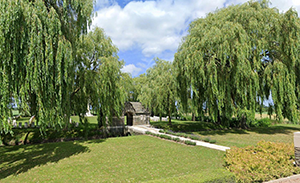
The cemetery is located a few kilometers south of the French village of Fleurbaix in the Pas-de-Calais department in Northern France, less than 10 kilometers from the Belgian border. It has an almost square design, a moat runs around the cemetery, and the cemetery mainly contains weeping willows, which contribute to the beautiful cemetery.
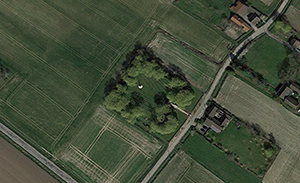 |
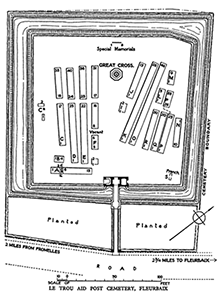 |
The entrance is located on the Rue du Petillon, where 2 stone posts give access to the path to the actual entrance to the cemetery. On the left post is mentioned 'LE TROU AID POST' and on the left post is mentioned 'CEMETERY 1914-1915'. Then there's a path to the entrance building which has a cottage stylish look. Along the path is an information panel with information about the cemetery and the Battle of Fromelles. In the entrance building you will find the cemetery register where the names of the buried are mentioned. There's also a visitor's book where you can write something during your visit.
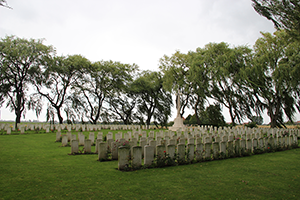
This cemetery contains 356 victims of the Great War, of which 207 are unidentified. They lie under a grave with the inscription 'A Soldier of the Great War, known unto God' or possibly mentioning his regiment, which sometimes was proven by the clothes or things they found on the body, such as a pin of the regiment.
Among the victims are soms distinguished soldiers:
- Arthur Willoughby George Lowry Cole, Brigadier General in the General Staff and Commander of the 25th Infantry Brigade, awarded the Distinguished Service Order (DSO) and the Order of the Bath (CB).
- Alan Knyveton Hargreaves, Captain in the Rifle Brigade, awarded the Distinguished Service Order (DSO).
- Richard Jellard Ford, Captain in the Worcestershire Regiment, awarded the Military Cross (MC).
- Reginald Percy Stoneham, Second Lieutenant in the Sherwood Foresters (Notts and Derby Regiment), awarded the Distinguished Conduct Medal (DCM).
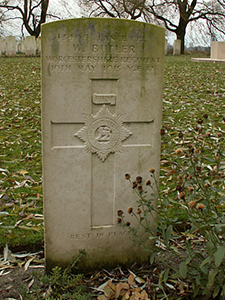 |
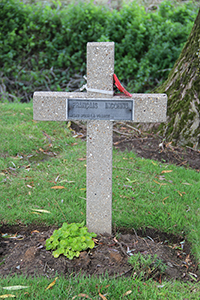 |
Le Trou Aid Post Cemetery was used for the first time between October 1914 and July 1915, relatively close to the beginning of the war. The cemetery was next to a regimental aid post and dressing station and not far from the support trenches that led to the frontline. 123 fallen were buried there towards the end of the war. After the war another 230 graves were moved there from the battlefields in the area of from smaller cemeteries that were cleared. La Haute Loge British Cemetery in Le Maisnil is one such cemetery. Most casualties fell during the heavy fighting in Le Maisnil in October 1914, the Battle for Aubers Ridge (9-10 May 1915), the Battle of Loos (25 September - 14 October 1915) and the Battle of Fromelles (19-20 July 1916). Five victims are commemorated with 'Special Memorials' because their graves can not be found anymore. On these graves is mentioned the text 'Known to be buried in this cemetery'. Among the identified victims are 138 British soldiers, 7 Canadian and 4 Australians. There are also 2 French graves.
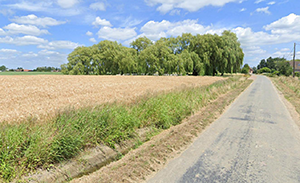 |
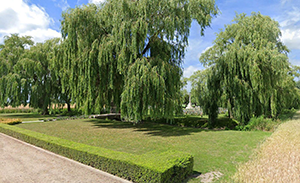 |
It was also in this area that Brigadier General Pompey Elliott of the 15th Brigade had his headquartes during the Battle for Aubers Ridge. The grave of the aforementioned Arthur Willoughby George Lowry Cole is prove of this, he was killed during the first attempt to take Fromelles on May 9, 1915.
80 graves of men of the 2nd Argyll and Sutherland Higlanders and the 1st Middlesex were transferred from La Haute Loge British Cemetery, they died on October 21, 1914. After holding the line for a long time against a majority, they were forced to retreat in the end. The enemy buried their dead on the cemetery a day later.

If you'te in the vicinity of Fromelles, Armentières, Lille, Heuvelland, Komen... do not hesitate to make a detour to this cemetery, it is well worth the visit. I visited it in 2014 at the end of my road trip along the WW1 frontline, from Colmar to the Flanders Field American Cemetery in Waregem.
Sources: www.cwgc.org | nicksbattlefieldtrips.com | Wikipedia | Google Earth